Science Daily News | 21 Jul 2023

Views (93)
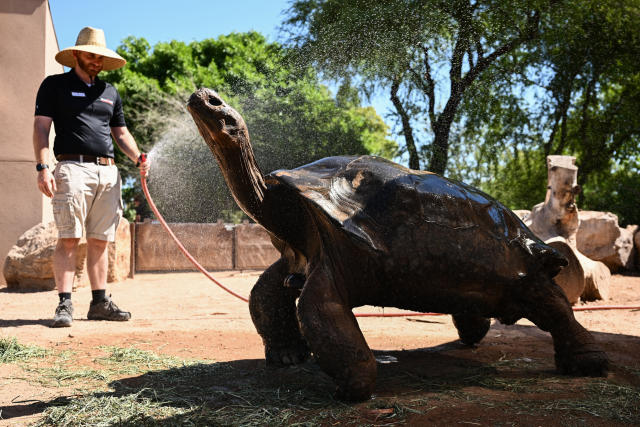
Satellite will die by fire as 1st-of-its-kind operation sends it plummeting down to Earth
Scientists will attempt a first-of-its-kind guided safe reentry to Earth's atmosphere with the European Space Agency wind satellite Aeolus as it heads home at increasing speed.
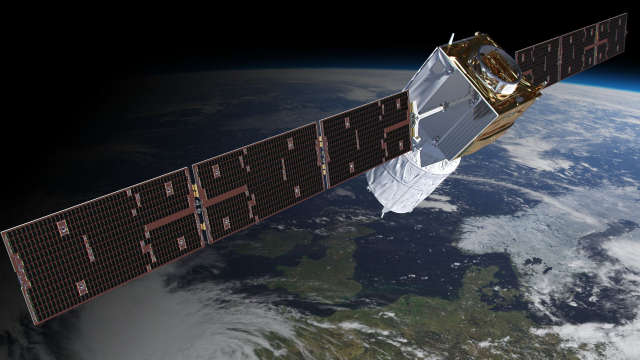
Scientists are preparing for a "first-of-its-kind" operation to steer a dead satellite back to Earth in a safe assisted re-entry.
"This is quite unique, what we're doing. You don't find really examples of this in the history of spaceflight," head of ESA's Space Debris Office Holger Krag said during the press briefing. "This is the first time to our knowledge, we have done an assisted re-entry like this."
Since then, the ESA satellite has been plummeting to Earth at an increasing speed falling from an altitude of 200 miles (320 kilometers)at a rate of around 0.62 miles (1 kilometer) a day, thus providing a unique opportunity to perform a guided re-entry attempt.
Planned in the 1990s, Aeolus wasn't designed with a guided re-entry in mind, and in normal circumstances, the ESA satellite would have simply undergone a natural descent back to the planet. In this case, however, scientists at ESA's Space Operations Center in Germany will use the craft's remaining fuel to steer Aeolus to the optimal point for re-entry.
The operation to bring Aeolus back to Earth begins on Monday (July 24) ESA Spacecraft Operations Manager Isabel Rojo Escude-Cofiner said during the press briefing. By Monday, the craft should have reached an altitude of 174 miles (280 kilometers) over Earth. The initial maneuvers will lower Aeolus to 155 miles (250 km) to put it in an elliptical orbit around the planet. "This will then be followed three days later by another set of maneuvers intended to lower it even further from 155 miles (250 km) to 93 miles (150 km) altitude," ESA Spacecraft Operations Manager Isabel Rojo Escude-Cofiner said during the press briefing. The final maneuver will happen on Friday (July 28), when the altitude of Aeolus will be further reduced to around 62 miles (100 km) over Earth. Within five hours of that final maneuver on Friday evening, the re-entry of Aeolus will occur. Escude-Cofiner explained that the satellite's descent corridor will bring it down over the Atlantic Ocean. As it falls, Aeolus will be tracked by a series of radar systems on the ground, allowing ESA experts to continue guiding it.
Even if this assisted reentry procedure goes according to plan, not all of Aeolus will make it back to Earth. The satellite will begin the shake and jolt around at about 50 miles (80 kilometers) over Earth, where it will begin disintegrating.
Krag said that the ESA team expects just 20% of the satellite to survive reentry, with 80% of Aeolus burning up in Earth's atmosphere. Krag explained that this 20% survival-rate is expected for such operations.
The team hasn't narrowed down a target landing zone, and as Aeolus won't come down in one piece meaning its landing zone effectively covers more or less the whole ocean area, according to Krag. As a result, there are no plans to recover the parts that do survive the journey back to Earth from their watery grave, with Krag adding: "We will not see any of these parts again."
RELATED STORIES:
With no plans in place to recover any of Aeolus, it is reasonable to ask what the purpose of this re-entry operation is.
The development of satellite reentry maneuvers such as this is vital due to the increased use of the space immediately surrounding Earth.
The guided return to Earth of Aeolus should lay the groundwork for these operations in accordance with new rules for space, which Krag compares to taking things to National Parks: "The things you take in with you, you take out again after the mission."
Most Americans expect routine space tourism by 2073, but few would actually try it: report
A Pew Research Center report reveals more than half of Americans expects to have access to space, but barely a third would be willing to make the trip themselves.
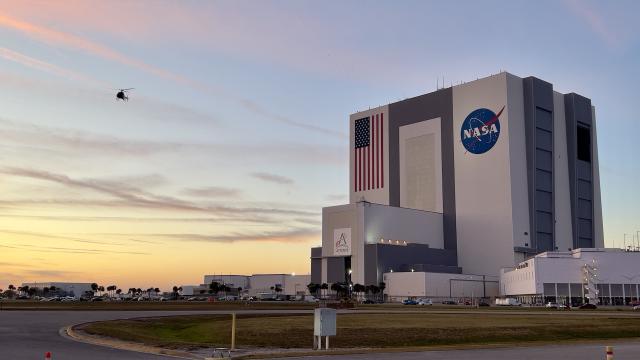
A new survey has found that more than half of all Americans expect to be able to travel to space within five decades.
Brian Kennedy authored the report with Alec Tyson and their team at Pew. They study public perception of different science and technology-related topics. "We thought this was an opportune time to kind of take a look at where the public stands on space-related issues after five years," Kennedy told Space.com.
"A lot has changed in the last five years," Kennedy said, adding, "We have the increasing involvement of private companies, space tourism seemingly becoming more of a reality and also more countries involved in space. Countries like India and China."
The Pew survey revealed 69% of Americans believe it is essential for the U.S. to remain an international leader in space exploration. But how that lead is maintained, and NASA's role in that leadership, versus the part of the private space industry, is not as universally agreed upon.
Listed much further down the priority list, ranked in the two bottom spots, are the 11 and 12% of people who believe NASA should prioritize human exploration of Mars or the moon, respectively. For both celestial destinations, 45% see it as "important but lower priority," with the remainder listing it as "not too important/should not be done." Searching for aliens and life-sustaining planets ranked higher as a top NASA priority, with 16%.
"Sizable shares are not sure," Kennedy said. "They're not sure of the performance of private space companies, and didn't rank them in these aspects. So that just speaks to the American public. There's a segment there that's largely unfamiliar with these companies and what they're doing."
For those with even a cursory interest in the commercial space industry (if you're reading this, you qualify), space companies got mostly good ratings. For building safe and reliable rockets and spacecraft, 48% think the private sector is doing a good job, and 47% think companies are making significant contributions to the space industry. 41% see the private space sector as a way for spaceflight to become accessible to more people.
As public opinions toward existing and emerging space companies evolve, 65% of Americans see NASA's ongoing involvement in the industry as a critical component to its long-term success.
Related Stories:
Rather than plan for a follow-up survey in another five years, Kennedy said the industry itself will help his team decide when is best to gather these type of data again. "We see space as one aspect that the public engages in with science," Kennedy said. "We're going to be watching to see what happens in space, and that'll determine the next future plans for survey related work on this topic."
The Pew Research Center's full report breaks down its findings into various demographic statistics, including gender and political affiliation, and also provides a full list of question wording and methodology.
How killer whale grannies spend their time postmenopause
Female orcas, like their human counterparts, live decades beyond their reproductive years.
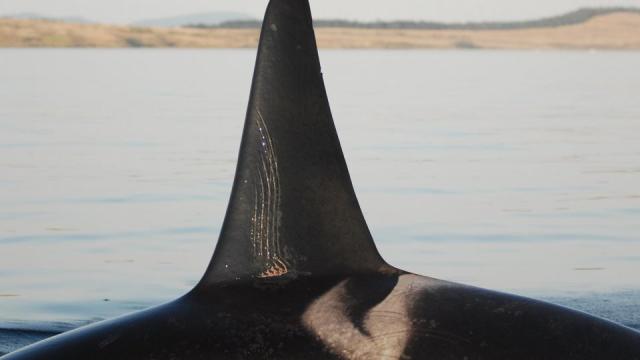
Female orcas, like their human counterparts, live decades beyond their reproductive years.
Scientists are trying to untangle why. In doing so, researchers are aiming to uncover more clues to the evolutionary purpose of menopause — a rare phenomenon in the animal kingdom.
Now, according to a new study published Thursday in the journal Current Biology, these orca matriarchs, which can live up to 90 years, also like to spend their later years indulging in some helicopter parenting of their sons. Female orcas help their sons navigate the complexities of orca social life and protect them from fights with other killer whales.
Orcas have no natural predators — except humans — and the tooth marks on their skin can only be inflicted by other killer whales, either within social groups or when two pods meet.
“Tooth rake marks are indicators of physical social interactions in killer whales and are typically obtained through fighting or rough play,” said lead study author Charli Grimes, an animal behavior scientist at the Centre for Research in Animal Behaviour at the UK’s University of Exeter.
It was possible older females used their experience to help their sons in encounters with other whales, Grimes said. The team is collecting drone footage of the whales to better understand the behavior.
“We think that these females use their enhanced knowledge of other social groups that obviously comes with time (and) experience … to help their sons navigate the interaction — whether that is signaling to them vocally or behaviorally,” she said. “That’s one hypothesis of how they might be protecting them. Another one is that they involve themselves in a conflict if a fight looks risky (for their son).”
The researchers found no evidence that postmenopausal orcas — which can expect to live some 22 years on average after they stop reproducing — reduce the bite marks on their daughters. Nor did breeding mothers or grandmothers reduce the rate of these socially inflicted injuries in their offspring.
“We can’t say for sure why this changes after menopause, but one possibility is that ceasing breeding frees up time and energy for mothers to protect their sons,” Grimes said.
Why not protect orca daughters? Grimes said that it makes more evolutionary sense for the orca matriarchs to focus on their sons because they have more potential to pass on their mother’s genes — and in a way that doesn’t put any additional burden on the group.
“Males have the opportunity to mate with multiple females, and they do this outside of their own social group. When a male’s calf is born … then the cost of that calf lies with the other group,” she said.
California Science Center starts complex process to display Space Shuttle Endeavour vertically
A highly technical process began Thursday in Los Angeles to put NASA's retired Space Shuttle Endeavour on permanent display in the vertical launch position complete with external tank and two solid rocket boosters. Workers used a crane to hoist the bottom segments of the boosters into the California Science Center's future Samuel Oschin Air and Space Center, which is currently under construction in Exposition Park. Officials say it will be the first time the procedure has been done outside of a NASA facility.
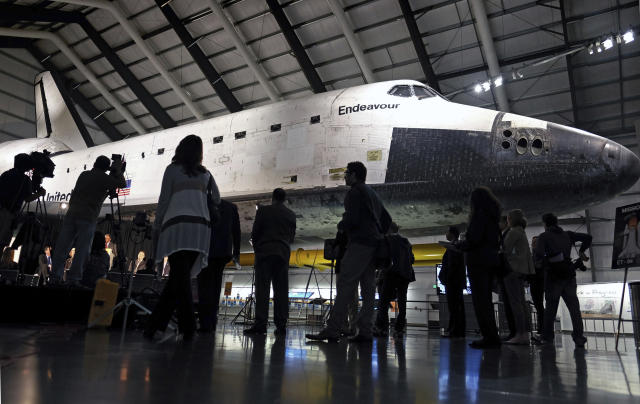
LOS ANGELES (AP) — A highly technical process began Thursday in Los Angeles to put NASA's retired Space Shuttle Endeavour on permanent display in the vertical launch position complete with external tank and two solid rocket boosters.
Workers used a crane to hoist the bottom segments of the boosters into the California Science Center's future Samuel Oschin Air and Space Center, which is currently under construction in Exposition Park.
The segments, called aft skirts, had to be precisely positioned so that the entire assembly can be stacked properly. Officials say it will be the first time the procedure has been done outside of a NASA facility.
The 20-story-tall display will stand atop an 1,800-ton (1,633-metric ton) concrete slab supported by six so-called base isolators to protect Endeavour from earthquakes.
Endeavour was built as a replacement for the destroyed Space Shuttle Challenger and flew 25 missions between 1992 and 2011.
When NASA’s shuttles were retired, Endeavour was flown to California atop NASA’s special Boeing 747 shuttle carrier in 2012, drawing crowds as it flew over locations in the state associated with the space program.
After landing at Los Angeles International Airport, the shuttle was placed on a special trailer and then created a sensation as it was inched through tight city streets to the California Science Center over several days.
Dec. 31 will be the last chance to see Endeavour as it has been displayed — horizontally in the landing position — for years since arrival at the California Science Center.
The shuttle will be moved across Exposition Park and lifted by a crane to be intricately mated to the external tank. Construction of the Air and Space Center will be completed around the full shuttle stack.
The center's foundation has raised nearly $350 million of the $400 million goal for the project.
As temperatures spike, so do cases of second- and third-degree burns
As record temperatures linger across the U.S., some are experiencing serious medical effects such as second- or third-degree burns and heat-related illnesses.

As temperatures soar in the Southwest, doctors say heat-related illnesses are not the only health hazards filling up emergency rooms. Cases of contact burns — some as severe as second- or third-degree burns — have significantly increased during this heat wave.
“The burns can be very severe and disfiguring to the point where you have to have what’s called a skin graft, where they take skin from other parts of your body and kind of cover it up,” she said.
Geren said two burn patients were admitted earlier this week right at the end of her shift — one who fell and was unable to get up and another who had a suspected seizure and was found on the ground with third-degree burns.
At least 10 people were treated for contact burns at Valleywise Health last week, according to a hospital spokesperson. Geren said she expects more to come as the heat wave persists into next week.
“The burn unit is very full,” she said. “It just keeps going.”
Contact burns occur every year when temperatures spike in the summer, but doctors said people should be extra cautious during severe heat waves.
Almost two weeks ago, Christopher Malcolm, a 73-year-old Air Force veteran, suffered third-degree burns while waiting for a bus in Las Vegas. He said it was about 110 F out that day and he started to feel overheated, so he sat down on the sidewalk.
“I guess the pavement was hot enough so that it burned, although I was wearing blue jeans,” he said, adding that he sat on the pavement for about 40 minutes and did not realize the severity of his injury.
Dr. Syed Saquib, a trauma burn surgeon at University Medical Center in Las Vegas, said superhot pavement can cause serious injuries in a short time.
“When the temperature in our valley gets above 100 degrees, 110 degrees, the pavement depending on the surface can heat up to 160 to 170 degrees Fahrenheit,” he said, “And all it takes is a couple of seconds of your skin being exposed to that to create a second-degree burn.”
Last weekend, as temperatures peaked across the Southwest, officials at the Las Vegas office of the National Weather Service measured temperatures on different surfaces when the ambient air temperature was 115 F, and found huge differences between rock, concrete and asphalt in the shade and in the sun.
For instance, a rocky sidewalk in the shade was 115.1 F, but was 155.8 F in the sun. While shaded asphalt registered as 128.4 F, that same type of surface in the sun was almost 158 F.
Malcom was scheduled to undergo surgery last Friday. He said this kind of injury was completely unexpected.
“I’ve dealt with heat before,” he said. “I lived in the Philippines for about seven years. Never had any problems with heat. I’ve been here about 22 or 23 years, never had any problems with heat until about 12 days ago.”
Still, Malcolm said, he’s grateful he did not collapse on the sidewalk or suffer even more serious injuries.
“I count myself lucky,” he said.
Denise Chow reported from New York, Erin McLaughlin from Las Vegas and Marissa Parra from Phoenix.
Blood-sicles and misters: Zookeepers look to keep animals cool in oppressive heat
Many of the Phoenix Zoo’s 3,000 animals are used to hot weather.

Many of the Phoenix Zoo’s 3,000 animals are used to hot weather. Still, with the city reaching a record 21 consecutive days of temperatures at 110 F or higher, zookeepers are having to get creative.
That means everything from fans and misters to frozen treats like ice pops for most animals and blood-sicles — frozen blood refreshments — for the carnivores, said Drew Foster, the zoo’s director of living collections.
“Even when it is incredibly hot, the staff still has to be here to take care of animals,” Foster said. “Instead of closing the zoo, we give animals access to climate-controlled areas and give them the care they need.”
Millions of Americans are in the midst of a multiweek heat wave, with record-breaking temperatures being recorded from the desert Southwest to Florida.
Animals are just as susceptible to the heat as people, and the National Weather Service has issued excessive heat warnings across the U.S., urging those in the heat wave’s path to stay hydrated, wear appropriate clothing and stay indoors when possible.
Zookeepers are particularly sensitive to these challenges, often having to care for a wide variety of animals with varying needs.
Phoenix zookeepers set careful temperature parameters and tailor heat plans for all animals under their care, Foster said. The horned rhinos, elephants and tortoises love water showers, while many of the big cats prefer a gentle misting. Zookeepers carefully monitor animals for signs of heat stress, such as panting.
Given the extreme heat, the Phoenix Zoo has also shifted its hours from 7 a.m. to 1 p.m., opting to welcome visitors during the coolest parts of the day and closing certain enclosures when necessary. The zoo has, however, stopped short of completely closing.
“One of our gorillas in particular loves the shower pool. It kind of looks like a person sitting in a hot tub,” said Kevin Hodge, the zoo’s vice president. “It’s really cute.”
“We definitely keep in mind that this is how things probably are going to be going forward,” said Anne Burgdorf-Moisuk, a veterinarian and the associate vice president of animal health and welfare at the Dallas Zoo. “And we’re going to have a lot of these hot summer days. So, how can we take care of our animals and also provide our guests with a great experience? How do we keep our animals safe and healthy?”
Part of the solution for the Phoenix Zoo includes conserving water for their animals, particularly because the facility is in an increasingly hot and dry desert climate, Foster said.
And in Dallas, the zoo is preparing for the future by more conscientiously planning animal enclosures and exhibits.
“We make adjustments and adaptations to our exhibit designs, and we have room in our budget for adjustments to extreme weather,” Hodge said. “Last summer, our howler monkeys were having a harder time in the heat than we anticipated, so we brought in temporary air conditioning. This summer, we made sure to install permanent air conditioning for the howler monkeys.”
0 Likes
